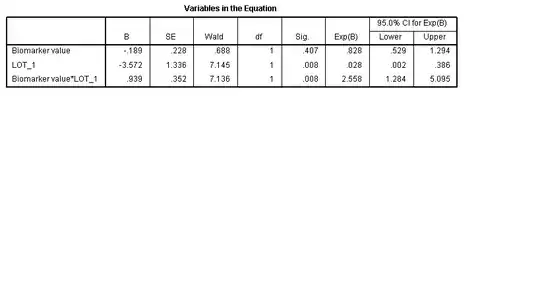The calculation of the $\hat A_i$ and $\hat B_i$ columns in Table 3 follows the development in Section 8 of the 1973 paper Stein's Estimation Rule and Its Competitors--An Empirical Bayes Approach, which is reference [8] in the 1975 paper. Let $n=36$ be the number of observations. For row $i$ in the table we define the vector $d_1,\ldots,d_n$ as motivated by Lemma 2:
$$
d_j := \begin{cases}3 &\text{if $j=i$}\\1&\text{otherwise}\\\end{cases}.\tag{8.10}
$$
The vector $E_1,\ldots,E_n$ is then calculated as:
$$
E_j := \frac{S_j-d_jD_j}{d_j},\tag{8.6}
$$
with $S_j:=X_j^2$. Then $I_1,\ldots,I_n$ are defined as functions of the real variable $A$ via
$$
I_j(A):=\frac{d_j}{2(A+D_j)^2}.\tag{8.7}
$$
Next, solve the equation
$$
A = \frac{\sum_{j=1}^n E_jI_j(A)}{\sum_{j=1}^nI_j(A)}\tag{8.8}
$$
for $A$ and call this value $\hat A_i$ (remember we are dealing with a fixed $i$). Having determined $\hat A_i$, then compute:
$$
d_i^*:= 2(\hat A_i + D_i)^2\sum_j\frac{d_j}{2(\hat A_i+D_j)^2}\tag{8.9}
$$
and finally:
$$
\hat B_i:=\frac{d_i^*-4}{d_i^*}\frac{D_i}{\hat A_i + D_i}.
\tag{8.11}
$$
It's unclear what column $\hat k_i$ contains, but it's very close to $d_i^*-2$, perhaps representing some kind of equivalent sample size for row $i$ (see the paragraph after (8.11)). This quantity $\hat k_i$ is not as crucial to the computation as $d_i^*$.
Here is R code to carry all this out:
dat <- read.csv("tox.csv", header=T)
n <- nrow(dat)
attach(dat)
S <- X**2
D <- sqrtD**2
est_A <- numeric(n)
dstar <- numeric(n)
est_B <- numeric(n)
est_theta <- numeric(n)
guess_k <- numeric(n)
for (i in 1:n) {
# Define d[1] .. d[n] to be 1, except d[i] = 3
d <- rep(1, n)
d[i] <- 3
# Define E[1] .. E[n]
E <- (S - d*D)/d
# Solve f(a)=0 for a
f <- function(a) {
I <- d / (a + D)**2 /2
a - sum(E * I)/sum(I)
}
# Solve using uniroot == one-dimensional root finder
est_A[i] <- uniroot(f, c(0, 1))$root
# Plug in est_A to calculate dstar, est_B, est_theta
I <- d/(est_A[i]+D)**2 /2
dstar[i] <- 2 * (est_A[i] + D[i])**2 * sum(I)
est_B[i] <- (1 - 4 / dstar[i]) * D[i] / (est_A[i] + D[i])
est_theta[i] <- (1 - est_B[i]) * X[i]
guess_k[i] = dstar[i] - 2
}
on data file tox.csv:
i,X,sqrtD,delta,A,k,B
1,.293,.304,.035,.0120,1334.1,.882
2,.214,.039,.192,.0108,21.9,.102
3,.185,.047,.159,.0109,24.4,.143
4,.152,.115,.075,.0115,80.2,.509
5,.139,.081,.092,.0112,43.0,.336
6,.128,.061,.100,.0110,30.4,.221
7,.113,.061,.088,.0110,30.4,.221
8,.098,.087,.062,.0113,48.0,.370
9,.093,.049,.079,.0109,25.1,.154
10,.079,.041,.070,.0109,22.5,.112
11,.063,.071,.045,.0111,36.0,.279
12,.052,.048,.044,.0109,24.8,.148
13,.035,.056,.028,.0110,28.0,.192
14,.027,.040,.024,.0108,22.2,.107
15,.024,.049,.020,.0109,25.1,.154
16,.024,.039,.022,.0108,21.9,.102
17,.014,.043,.012,.0109,23.1,.122
18,.004,.085,.003,.0112,46.2,.359
19,-.016,.128,-.007,.0116,101.5,.564
20,-.028,.091,-.017,.0113,51.6,.392
21,-.034,.073,-.024,.0111,37.3,.291
22,-.040,.049,-.034,.0109,25.1,.154
23,-.055,.058,-.044,.0110,28.9,.204
24,-.083,.070,-.060,.0111,35.4,.273
25,-.098,.068,-.072,.0111,34.2,.262
26,-.100,.049,-.085,.0109,25.1,.154
27,-.112,.059,-.089,.0110,29.4,.210
28,-.138,.063,-.106,.0110,31.4,.233
29,-.156,.077,-.107,.0112,40.0,.314
30,-.169,.073,-.120,.0111,37.3,.291
31,-.241,.106,-.128,.0114,68.0,.468
32,-.294,.179,-.083,.0118,242.4,.719
33,-.296,.064,-.225,.0111,31.9,.238
34,-.324,.152,-.114,.0117,154.8,.647
35,-.397,.158,-.133,.0117,171.5,.665
36,-.665,-.216,-.140,.0119,426.8,.789
